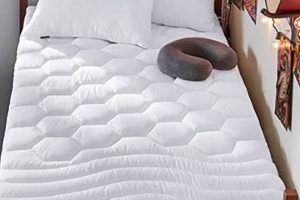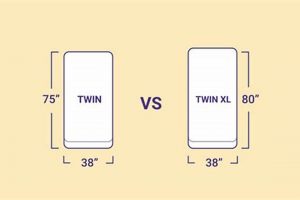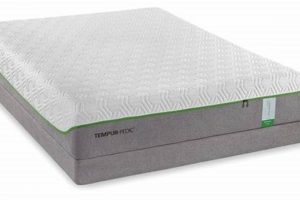The comparison centers on two mattress sizes: the full, also known as a double, and the full XL. A full mattress typically measures 54 inches wide and 75 inches long. A full XL mattress maintains the 54-inch width but extends the length to 80 inches. This additional length primarily benefits taller individuals who might find a standard full mattress too short. For example, a person over 6 feet tall might experience greater comfort on a full XL due to the added legroom.
The relevance of these dimensions lies in optimizing sleep quality and comfort. Adequate mattress size ensures sufficient space for undisturbed rest, preventing issues like hanging off the edge of the bed. Historically, the full size mattress was a standard choice for single sleepers, but changing height averages have increased the demand for longer options. This evolution reflects a growing awareness of the correlation between sleep surface dimensions and overall well-being.
The subsequent discussion will delve into the specific advantages and disadvantages of each size, considering factors such as room size, cost, and suitability for different sleepers. Furthermore, it will explore alternative mattress sizes and provide guidance on selecting the optimal choice based on individual needs and preferences.
Key Considerations
This section outlines critical factors to evaluate when choosing between a full XL mattress and a full mattress. These tips address practical concerns related to space, comfort, and cost.
Tip 1: Assess Sleeper Height: Individuals exceeding 5’10” should strongly consider the full XL mattress. The additional 5 inches of length can significantly improve sleep quality by preventing discomfort from cramped legroom.
Tip 2: Evaluate Room Dimensions: Full mattresses are typically more suitable for smaller bedrooms. Measure the available space to ensure adequate room for the bed and surrounding furniture. A full XL mattress requires a slightly larger area.
Tip 3: Consider Budget Constraints: Full mattresses generally cost less than full XL mattresses. Budgetary limitations may influence the final decision, particularly for those on a tight spending plan.
Tip 4: Analyze Sleep Style: Individuals who tend to stretch out during sleep may benefit from the extra length of a full XL mattress. Those who sleep in a more compact position may find a standard full mattress sufficient.
Tip 5: Anticipate Future Needs: If growth spurts are anticipated (e.g., for teenagers), a full XL mattress provides greater long-term utility, preventing the need for a mattress upgrade in the near future.
Tip 6: Compare Bedding Availability: Standard full mattress bedding is more readily available and often more affordable than full XL bedding. This should be a factor during the decision-making process.
Selecting the optimal mattress size requires careful consideration of individual needs and circumstances. Prioritizing height, room size, budget, and sleep style will lead to a more informed and satisfactory choice.
The subsequent section will summarize the core differences and similarities between these mattress types, solidifying the understanding necessary for a well-informed purchase.
1. Length
The dimension of length serves as a primary differentiator between a full XL mattress and a standard full mattress. This distinction directly impacts comfort, particularly for sleepers of varying heights. A comprehensive understanding of length’s role is essential when selecting the appropriate mattress size.
- Primary Difference:
The core distinction lies in the overall length measurement. A standard full mattress measures 75 inches in length, while a full XL mattress extends to 80 inches. This five-inch difference is the defining characteristic.
- Impact on Taller Sleepers:
Individuals exceeding approximately 5’10” (70 inches) often find a standard full mattress too short, leading to discomfort as their feet hang off the edge. The added length of a full XL alleviates this issue, promoting better spinal alignment and sleep quality.
- Room Size Considerations:
The increased length of a full XL mattress necessitates a slightly larger bedroom space. While the width remains consistent with a standard full, the additional length requires careful planning to ensure sufficient room for movement and furniture placement. Measurements should be taken prior to purchase.
- Influence on Sleep Position:
Sleepers who prefer to stretch out fully during sleep benefit from the extra length provided by a full XL mattress. Regardless of their height. The availability of extra space reduces the likelihood of restricted movement and associated discomfort.
In summary, length is a critical factor in evaluating the suitability of a full XL or full mattress. The impact of this dimension on sleeper comfort, room size requirements, and preferred sleep position should be carefully considered to make an informed decision, prioritizing restful sleep.
2. Room Size
Room size is a determining factor when choosing between a full XL mattress and a full mattress. The dimensions of the room dictate the suitability of each mattress type, directly impacting usability and comfort. A smaller room may preclude the use of a full XL mattress, whereas a larger room can comfortably accommodate either option. The cause-and-effect relationship is clear: limited square footage restricts mattress choice, while ample space provides greater flexibility. For instance, a bedroom measuring 10 feet by 10 feet might feel cramped with a full XL mattress, limiting walking space and impacting overall room functionality. Conversely, a bedroom of 12 feet by 12 feet can easily accommodate a full XL without significant disruption.
The practical significance of understanding this connection lies in optimizing living space. Purchasing a mattress that overwhelms a room can hinder mobility, reduce storage options, and negatively affect the aesthetic appeal. A real-life example is a studio apartment dweller who opts for a full XL mattress without considering the limited space. The bed dominates the room, making it difficult to navigate and reducing the usability of other furniture. Careful measurement of the room and consideration of existing furniture placement are crucial. Failure to adequately assess room size prior to purchase can lead to dissatisfaction and the potential need for costly returns or exchanges.
In summary, the correlation between room size and mattress selection is significant. Choosing a mattress that fits proportionally within the room enhances both comfort and functionality. Challenges arise when aesthetic preferences clash with spatial constraints, requiring a careful balancing act. A thorough assessment of room dimensions, coupled with an understanding of personal space requirements, facilitates a well-informed decision that optimizes the sleeping environment. This consideration is integral to achieving the core objective: a comfortable and functional bedroom layout.
3. Cost
Cost serves as a substantial differentiator between full XL mattresses and standard full mattresses. A direct relationship exists: full XL mattresses generally command a higher price point. The underlying cause stems from the increased material usage required to produce the extended length. This difference translates into practical implications for consumers. For example, a budget-conscious shopper might find a suitable full mattress significantly more affordable than a comparable full XL model from the same brand. The economic impact is magnified when factoring in associated costs such as sheets, mattress protectors, and bed frames, as these items may also carry a higher price for the full XL size. The magnitude of the price differential varies by brand, material, and retailer, but the overall trend remains consistent. Ignoring this price discrepancy during the purchasing process can lead to financial strain or the need to compromise on desired features.
Real-world scenarios illustrate the importance of considering cost. Consider a college student furnishing a dorm room. A full mattress might be a practical and cost-effective choice given space limitations and budgetary constraints. Conversely, an adult furnishing a master bedroom might prioritize the added comfort of a full XL mattress, viewing the higher cost as an investment in improved sleep quality. The practical application lies in aligning mattress selection with personal financial circumstances. A detailed comparison of prices across various brands and retailers is crucial, as is exploring options such as sales, discounts, and financing plans. Moreover, evaluating the long-term value proposition considering factors like durability and warranty can provide a more comprehensive understanding of the true cost of ownership.
In summary, cost is a critical component in the full XL mattress vs. full mattress comparison. The price difference reflects the increased material required for the full XL, leading to practical implications for budget-conscious consumers. The challenge lies in balancing the desire for enhanced comfort with financial realities. A thorough assessment of prices, coupled with a consideration of long-term value, facilitates a financially sound decision that aligns with individual needs and preferences. The financial commitment must be integrated into the overall decision-making process to ensure a satisfactory outcome.
4. Height
Height is a critical determinant in the choice between a full XL mattress and a standard full mattress. A direct correlation exists: taller individuals are more likely to benefit from the increased length of a full XL mattress. The underlying cause is the inadequate support offered by a standard full mattress to individuals exceeding approximately 5’10”. This lack of support manifests as discomfort, disrupted sleep, and potential spinal misalignment, as extremities hang off the edge of the bed. For instance, a person measuring 6’2″ using a standard full mattress will experience a notable degree of discomfort due to insufficient legroom. The practical significance lies in promoting proper spinal alignment and ensuring restful sleep. Ignoring the height factor can negate other benefits of a high-quality mattress, such as pressure relief and motion isolation. The suitability of a mattress is thus contingent upon the sleeper’s stature.
A real-world example highlights the consequences of neglecting the height factor. A growing teenager transitioning from a twin bed to a full-sized mattress may initially find the standard full adequate. However, as the individual continues to grow, the mattress will eventually become too short, necessitating a replacement. Choosing a full XL mattress from the outset mitigates this need for an upgrade. The practical application of this understanding involves proactively considering growth patterns, particularly for adolescents. Furthermore, individuals sharing a bed must account for the taller partner’s needs, as compromised sleep for one can negatively affect the other. Careful attention to individual height, or heights in the case of couples, is therefore crucial in the selection process.
In summary, height is a primary consideration when evaluating a full XL mattress versus a full mattress. The correlation between height and mattress length directly impacts sleep quality and comfort. The challenge lies in accurately assessing individual height and anticipated growth to make an informed decision. Integrating height into the decision-making process ensures that the selected mattress provides adequate support and promotes restful sleep, ultimately contributing to overall well-being.
5. Bedding
The availability and cost of bedding represent a significant, often overlooked, factor when deciding between a full XL mattress and a standard full mattress. A direct relationship exists: standard full-size bedding is more readily available and generally less expensive than bedding designed for full XL mattresses. This disparity stems from market demand and production volume. Standard full mattresses are more common, leading to a greater supply and more competitive pricing of associated bedding. A full XL mattress, being less prevalent, necessitates specialized bedding that often incurs higher production costs, ultimately passed on to the consumer. For example, a complete sheet set for a standard full mattress may cost significantly less than a comparable set for a full XL mattress of similar quality. The economic implications are notable, especially for budget-conscious consumers or those furnishing multiple beds.
This difference in bedding availability and cost extends beyond sheet sets to include mattress protectors, comforters, and bed skirts. While standard full-size options are widely stocked in retail stores and online, finding suitable full XL options may require specialized searches or direct orders from manufacturers, potentially leading to longer lead times and increased shipping expenses. A practical example involves a homeowner furnishing a guest room. Opting for a standard full mattress simplifies the bedding acquisition process, allowing for convenient purchases from readily available sources. In contrast, choosing a full XL mattress introduces the challenge of sourcing compatible bedding, potentially requiring more time and effort. The practical application of this understanding lies in factoring bedding costs into the overall mattress selection decision, recognizing that the initial mattress price represents only a portion of the total investment.
In summary, bedding is an integral component of the “full xl mattress vs full” equation. The relative scarcity and higher cost of full XL bedding present a practical consideration that should influence purchasing decisions. Challenges arise when aesthetic preferences or specific comfort needs necessitate the full XL size despite the increased bedding expenses. Thorough research into bedding availability and pricing, coupled with a realistic assessment of budgetary constraints, facilitates a well-informed decision. This approach ensures that the chosen mattress not only meets comfort requirements but also aligns with financial realities, preventing unexpected expenses and simplifying the bedding acquisition process.
6. Availability
Availability, in the context of “full xl mattress vs full,” directly influences consumer choice and purchasing convenience. The ease with which a particular mattress size can be sourced, both online and in brick-and-mortar stores, impacts the overall desirability and practicality of the selection process. Relative scarcity can drive up prices and extend delivery times, factors that ultimately affect consumer satisfaction.
- Retail Presence
The physical presence of full and full XL mattresses in retail stores dictates the opportunity for consumers to perform in-person comparisons. Standard full mattresses are typically stocked more extensively, allowing for immediate tactile assessment of firmness, material, and construction. Full XL mattresses may be less common, requiring consumers to visit specialty stores or rely on online descriptions without the benefit of pre-purchase tactile evaluation. This unequal retail presence can skew consumer preferences toward the more readily available option.
- Online Inventory
Online retailers offer a wider range of choices compared to brick-and-mortar stores. However, the availability of full XL mattresses can still be limited depending on the vendor. Search filters, inventory management systems, and shipping logistics can influence the visibility and accessibility of full XL models. Consumers may encounter out-of-stock situations, delayed delivery dates, or limited color and style options compared to the standard full-size offerings. This disparity can affect the decision-making process, particularly for those seeking immediate gratification.
- Bedding and Accessories
As noted previously, the availability of compatible bedding and accessories significantly impacts the overall practicality of each mattress size. Full mattresses benefit from a vast and readily accessible market for sheets, mattress protectors, bed frames, and other essentials. Full XL mattresses require specialized items, which can be harder to find and more expensive. The ease of acquiring these necessary accessories directly influences the perceived value and convenience of each mattress choice.
- Brand and Model Variety
The range of brands and specific mattress models available in each size category also affects consumer choice. While numerous manufacturers produce standard full mattresses, fewer may offer full XL options. This limited variety can restrict the ability to compare features, technologies, and price points, potentially forcing consumers to settle for a less-than-ideal option simply due to availability constraints. Brand recognition and perceived quality can also be influenced by the prevalence of each size within a particular manufacturer’s product line.
In conclusion, availability serves as a practical constraint on the “full xl mattress vs full” decision. Unequal retail presence, online inventory limitations, accessory scarcity, and reduced brand variety all contribute to a skewed playing field. Consumers must carefully weigh the benefits of each mattress size against the potential inconveniences associated with sourcing and acquiring the preferred option. This assessment is critical to ensuring satisfaction and maximizing the overall value of the purchase.
Frequently Asked Questions
This section addresses common inquiries regarding the distinctions and suitability of full XL and full-size mattresses. The aim is to clarify potential points of confusion and provide concise, factual responses.
Question 1: Is a full XL mattress simply a longer version of a standard full mattress?
Yes, the primary difference is the length. A full XL mattress measures 80 inches in length, whereas a standard full mattress measures 75 inches. The width remains consistent at 54 inches.
Question 2: For whom is a full XL mattress best suited?
A full XL mattress is most appropriate for individuals exceeding approximately 5’10” in height. The extra length prevents discomfort and ensures adequate legroom.
Question 3: Does a full XL mattress require specialized bedding?
Yes, full XL mattresses necessitate specifically sized sheets, mattress protectors, and other bedding accessories. Standard full-size bedding will not fit properly.
Question 4: Is a full XL mattress more expensive than a full mattress?
Generally, full XL mattresses carry a higher price point compared to standard full mattresses, due to the increased material required in their construction.
Question 5: Does a full XL mattress require a larger bedroom space?
A full XL mattress requires slightly more room length-wise than a standard full. Careful measurement of the intended bedroom space is advised prior to purchase.
Question 6: Are full XL mattresses as readily available as full mattresses?
No, full XL mattresses are typically less common than standard full mattresses in both physical retail locations and online marketplaces.
In summary, the full XL mattress provides additional length for taller individuals but entails higher costs and requires specialized bedding. The standard full mattress offers affordability and greater accessibility but may prove insufficient for taller sleepers.
The subsequent section will provide concluding remarks and final recommendations regarding mattress selection.
Full XL Mattress vs Full
This exposition has presented a detailed analysis of the distinctions between full XL and full mattresses. The examination encompassed length, cost, room size considerations, height suitability, bedding availability, and overall market prevalence. The findings reveal a nuanced landscape wherein the optimal choice hinges on individual requirements and practical constraints. The longer dimensions of the full XL cater specifically to taller individuals, while the standard full offers greater affordability and accessibility. Neither option represents a universally superior solution; rather, each addresses distinct needs and preferences.
Therefore, prospective purchasers should meticulously evaluate their personal circumstances before committing to a selection. Height, room dimensions, budgetary limitations, and bedding preferences must be carefully weighed against the demonstrated advantages and disadvantages of each mattress type. Informed decision-making, grounded in a thorough understanding of the aforementioned factors, will ultimately yield the most satisfactory and enduring outcome, ensuring a comfortable and restful sleep experience.







